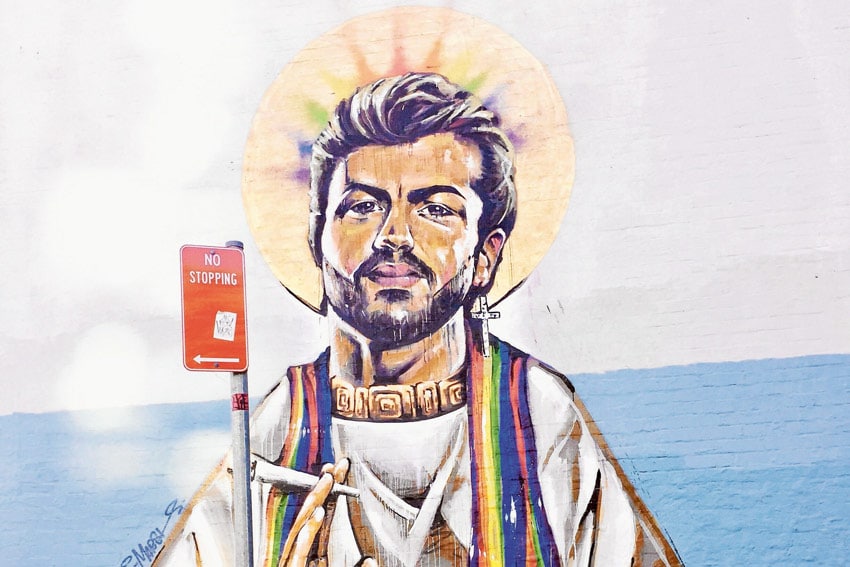
“Is nothing sacred?”
This question, often asked in exasperation and framed as rhetorical, is probably worth answering at this point because increasingly, it seems like nothing is.
Last month, 23-year old Ben Gittany was found guilty of vandalising a mural of George Michael in Newtown. He was sentenced today to 300 hours community service and a $14,000 fine.
Many people might remember video footage of Ben painting over the mural in November last year. A bucket of black paint by his side, he calmly covered the mural while being filmed by local residents who were yelling at him to leave.
“I’ve done nothing wrong. I’m defending my religion,” Ben is heard saying in the video. “That’s Jesus.”
A couple of weeks ago, Nicholas Stewart – a human rights lawyer writing for the Sydney Morning Herald – described the mural of George Michael as a “beautiful, peaceful artwork.”
Recognising the mural as obviously being based on an image of the Sacred Heart of Jesus, an image that has been venerated by Catholics for centuries, people of faith would not describe the mural as peaceful. They would describe it as a sacrilege. Others might describe it as cultural appropriation. Most would describe it as provocative.
Instead of Jesus’ right hand raised in a blessing, the image shows Michael’s hand raised to smoke a joint. The left hand in the original image points towards Jesus’ heart. In the mural, the left hand is clutching a bottle of poppers. A golden halo is replaced with one tinted with rainbow lights, and – to ensure you don’t miss the Christian theme – “saint” George Michael wears a cross-shaped earring.
Scott Marsh, the artist who had painted the mural, was also responsible for the other mural of Tony Abbott and Cardinal George Pell painted on another pub in Newtown. In that image – painted to celebrate the same-sex marriage vote – Abbott is painted wearing in a wedding dress while Cardinal Pell is pictured wearing nothing but a zucchetto and speedos. In the image, Abbott’s hand is inside the front of the Cardinal’s swimwear. It’s completely disgusting.
Ignoring the obvious and instead attempting to pass these images off as ‘peaceful’ doesn’t pass the pub test, even in the hipster, Coopers beer-banning pubs of Newtown whose patrons might agree that nothing is, or should be sacred, in modern Australia.
And the law agrees with them. In New South Wales, at least, nothing is sacred.
A mural mocking, or at least appropriating, Christianity, is a safe bet for any artist in this state because there are no laws against religious vilification here. Indeed, NSW does not even have a law against discrimination on the grounds of religion.
Not only are anti-Christian murals allowed to be painted on private properties in Newtown, businesses open to the public can hang “No Christians served here” signs in their windows and still be within the bounds of the law.
The mural is a perfect example of the imbalance that currently exists in NSW anti-discrimination law.
Christians who were upset or offended by the George Michael or Abbott-Pell murals had only one legal option: they could “choose” to ignore it. Doing anything else was against the law, as Ben Gittany found out when he was convicted of malicious damage in court.
The penalty for malicious damage could have included imprisonment for up to 5 years and, while sparing him a prison sentence, Magistrate Carolyn Huntsman still classed the crime as ‘serious.’ In sentencing Gittany, Magistrate Huntsman reportedly said:
“You travelled to someone else’s community and imposed your views on them with an act that was criminal and harmful. What was left was a large area of black paint which arguably was a disturbing message of rejection to the community and arguably a contempt for other people. We are not a community where violence, criminal acts and property destruction are sanctioned because you have different beliefs to other people. They had to look at it for months. It distressed the owner and the community, and it was extensive.”
Contrast the sentence – and the commentary – to what would happen under NSW law if someone had painted a mural that ridiculed a person or a group on the basis of their sexual orientation, gender identity or HIV/AIDS status in the exact same location. Those who took offence would not have the singular option of ignoring it. They could also choose to make a complaint to the NSW Anti-Discrimination Board and seek an apology, damages up to $100,000 and the removal of the image.
It seems that some murals are more equal than others, at least in NSW.
Whatever you think of Mr Gittany’s actions, one thing he has done is highlight the lack of legal recourse for Christians and other people of faith who have been ridiculed, vilified or discriminated against.
For all the hand-wringing and garment-rending suggestions that the Ruddock review might open up a ‘license to discriminate’ for people of faith, people of faith are asking whether the review will even go as far as to correct the imbalance that currently exists in NSW anti-discrimination laws.
